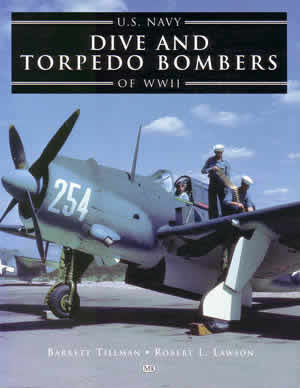
USN Dive and Torpedo Bombers of WW II
Book review by Fred Lane
Tillman B and R.L. Lawson. US Navy dive and torpedo bombers of WW II. MBI Publishing: St Paul. 2001. Paperback 128 pp with index and photographs.US$24.95.
This highly interesting book, together with a companion piece, US Navy Fighters of WW II, vividly describe the vitally important parts played by USN aircraft and their aircraft carriers in WW II. It is not a “mom and apple pie” book. It critically analyses the shortcomings of some aircraft types and some misguided tactics. No matter how good a new aircraft type looks on paper, if it is not developed properly and flown with commonsense, it tends to kill the wrong people.
On the other hand, recovering from an appalling start with inferior aircraft on that “day of infamy” 7 December 1941, the USN, aircraft manufacturers and especially operational aircrew forged a strike weapons system that halted and turned back the then seemingly invincible Japanese. USN dive and torpedo bombers had an important anti-shipping role, but they were never employed simply to sink ships.
The same aircraft that sank the biggest battleship in the world, HIJMS Yamato in 1945, also enabled Nimitz’s highly successful direct thrust strategy. The WW II Pacific Ocean battles might have been bigger than anything in naval history yet, but to put the USN’s strike effort in perspective, “From 1942 through 1945, only 18.8 per cent of carrier aircraft sorties were launched against enemy ships” (p.113). The remainder were chiefly strikes against land targets, invaluable close air support to invading ground troops and fighter defence.
Naval historians Tillman (see In harm’s way: The saga of Gambier Bay) and Lawson (see USN navy Fighters of WW II) show how the USN, like the RN’s Fleet Air Arm, were woefully under-equipped at the outbreak of WW II, with an inventory of only 239 scouts, dive bombers and torpedo planes, “including 89 biplanes” (p. 8) embarked in five aircraft carriers. On 7 December 1941, six Japanese carriers launched 386 aircraft, including the then incomparable Zero fighter, to attack Pearl Harbor. By an amazing stroke of good fortune, the American carriers were at sea. They were the kernel from which all initial retaliation sprang and from which grew the versatile and overwhelming force it is today.
Hard times
The early WW II days were hard. The first all-carrier naval battle in history was fought in the Coral Sea that laps Australia’s shores, in May 1942, when aircraft from the USS Lexington and Yorktown sank the light Japanese carrier Shoho, but at the cost of the much more valuable fleet carrier Lexington. The Americans more than evened the score, with the help of some clever signals intelligence, on 4-5 June at Midway. Tillman and Lawson show how the tempo of USN strike operations increased, particularly with the introduction of the Grumman TBM/TBF Avenger and the magnificent Essex class carriers.
The Grumman TBM/TBF Avenger quickly replaced both the TBD-1 Devastator and SB2U Vindicator torpedo bombers/scouts. Meanwhile, the well-loved SBD-2/SBD-3 Douglas Dauntless became the dive bomber of choice. Devastator crews experienced 83 per cent losses at Midway while on the other hand the Dauntless dive bomber was credited with sinking all four Japanese carriers. A planned Dauntless replacement, the new Curtiss SB2C Helldiver, arrived in April 1942, but with expectations not matched by performance. “Problems as diverse as hook skip, collapsed landing gear and structural failures cast a cloud over the entire program,” Tillman and Lawson note (p. 44).
There are dozens of excellent quality photographs of naval aviators, their carriers and their aircraft in the book. It is recommended reading.
